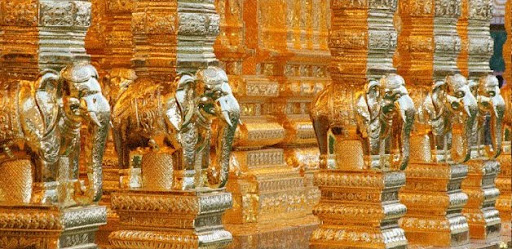
Below is a detailed description of the ceremony and the meaning of various rituals.
The priest recites Sanskrit mantras from the Vedas in the presence of agni (the sacred fire). Agni, the sacred purifier and benefactor, is deemed a witness to the marriage rites. With the grace of the vedic mantras and the blessings of the elders, the couple begins their journey of married life.
Prelude Rituals
Ganesha Puja
parents seek the blessings of Lord Ganesha (the elephant faced deity) for the removal of all obstacles and the success of the ceremony.
Vratham
This is a ritual conducted by the bride and groom with their parents. Prayers are offered to ensure that all goes well with the alliance. The groom is given a set of veshti by the bride’s parents. Sacred threads are dipped in turmeric are tied on the bride and groom’s wrists to protect them from inauspiciousness.
Paligai Navadanyam (sprouting of the seeds)
This is done by married women, symbolizing fertility and growth of progeny.
Kashi Yatra
Here, the groom sets off on a pilgrimage towards the holy city of Kashi, on the bank of the Ganges in search of spiritual knowledge. But as he leaves, the bride’s father meets him and convinces him to stay and marry his daughter. He agrees, and he proceeds toward the marriage hall.
Exchange of Garlands & Oonjal (the swing)
The groom meets the bride, they exchange garlands three times, then sit in a swing. Just as the two chains of a swing move together connected by one plank, the couple will jointly face the oscillations of life, sharing the joy and sorrow together. The elders then carry a lighted lamp and pour water around the swing to invoke Shri (auspiciousness). Colored balls of rice are thrown in different directions to lure away undesirable spirits, and music is played to drown out inauspicious sounds.
Marriage Rituals
Ganesha Puja & Sankalpam
Anu, Vijay, and their parents worship Lord Ganesha and express their intentions for the marriage ceremony.
Kanyaka Dhanam
The bride’s father, taking the bride’s hand in his, offers his most precious gift to the bridegroom. The groom’s parents then present the bride with the traditional nine-yard sari. The mangalyam (a gold pendent bearing symbols of the family deity on a yellow thread) is placed on a plate and presented to the elders and other guests for their blessings.
Vadhuparishuddhi (purification of the bride)
A small yoke is placed on the bride’s head and on it is placed a piece of gold, signifying auspiciousness. Water is poured through a hole in the yoke while mantras are chanted, invoking Surya (the sun), Varuna (the water), and other deities to purify the bride in preparation for a harmonious married life.
Mangalya Dharanam (tying the gold pendant)
This auspicious moment (muhurtham) is fixed according to the bride’s birth star. The groom takes the mangalyam, and fastens the first knot around the bride’s neck while chanting a mantra. Because marriage is not only a union of two inviduals, but is a union of two families, the groom’s sister fastens two more knots, symobolizing acceptance of the bride into the groom’s family.
Panigrahanam (holding the bride’s hand)
The groom lowers his right palm on the bride’s right hand and prays for a long life, progeny, prosperity, and harmony with the bride during their married life, marking the beginning of a new relationship.
Saptapadi (the Seven Steps)
This is the most important part of the marriage ceremony. Only when the bride and groom walk the seven steps together, is the marriage complete. The groom holds the bride’s right toe with his right hand and helps her take seven steps while reciting the vedic mantras.
Pradhana Homam (the main fire ritual)
The couple pay homage to Agni (fire) by doing pradakshina (going around), offering ghee, and chanting mantras.
Asmarohanam (stepping on the stone)
The groom helps the bride place her right foot on a special stone and he chants, “May you be strong and unshakable like this stone, face the challenges of life, and withstand all adversities.”
Laja Homam (offering puffed rice)
The bride’s brothers fill her cupped hands with puffed rice, which she offers to the fire. The bride recites mantras, praying for her husband’s well-being and a married life filled with peace and harmony. After each offering the couple circles the fire and the bride steps on the stone as above.
Sakhya Homam (ritual for friendship)
The couple offers oblations to fire chanting mantras for lasting friendship through mutual understanding.
Ashirvadam (blessings from the elders)
The couple, now husband and wife, seek blessings from the elders and guests present at the function.















